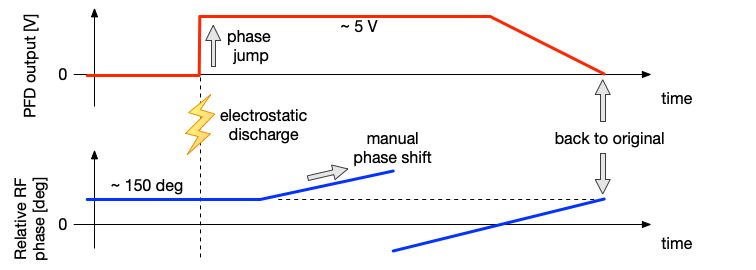Satoshi and Kiwamu,
Related logs: 17188, 17235.
We performed a health checkup for the PFD unit (S1809057) in the Mozumi electronic lab yesterday and found no obvious faulty behaviors.
In addition, we were able to reproduce the strange behavior of the PFD unit changing the output voltage in response to an electrostatic discharge event nearby.
The unit was put back into the ALS1 rack yesterday to see if the unit really picks up electrostatic discharge events in the experimental area even no one is around i.e., during the night time. The answer seems to be NO so far as described in 17235. The increased noise we have seen appear to be something different than the discharge-triggered glitches.
It could be that we were worried too much about the discharge-triggered glitches.
Health checkup
We performed two types of measurements to see if the electronics are functional.
- Measurement of RF level in the signal paths
- Measurement of the supply voltages for the active components
The details are summarized in E2113026-v1. Since we found it difficult to access the electronics for the Y PLL channel due to the way the electronics were accommodated in the chassis, we tested the X PLL channel (i.e., the upper part of the contents in the chassis), only. We did not find an obvious faulty sign and concluded that the unit was healthy.
Response to electrostatic discharge
The electrostatic discharge in this context is a discharge event taking place physically far and at an electronically isolated point. For example, we simulated the discharge event by using the piezo-electric ignition device embed in a lighter held in one's hand. In our test, the person who operates it usually holds the lighter in a hand and simply clicks the ignition device so as to create a discharge event. The PFD unit turns out to be sensitive to such a discharge event at a distance of 1 meter or so at maximum. The closer the event to the electronics, the more often the unit reacts to it.
The below shows an illustration of the typical behavior.

In the test, we injected two RF signals into the X PLL unit. One is the LO signal and the other is the RF signal. Both are generated from the Moku-lab configured for the arbitrary waveform mode. The frequencies of the two signals are set to the identical value of 40.000 MHz. The LO signal is set to be approximately 10 dB and the RF be -20 dB in order to simulate the realistic condition. The relative phase was initially adjusted such that the PFD output hovers around zero volt.
As we create a discharge event, the PFD output jumps to either +5 or -5 V. Sometimes, the PFD does not react to the discharge and stays at the same output voltage value. Usually, the jump happens with a probability of ~50% or so for a single discharge event. We were unable to locate which electronic component was the most sensitive because it reacted regardless of where the discharge event was as long as the event was within a meter or so from the unit.
An interesting point is that, we can get back to the original condition by manually shifting the relative phase by exactly 2 pi. This is illustrated in the cartoon above. In the cartoon, if we went to downward in the relative phase, the PFD output would jump to -5V at some point and would come back to the same value when the 2 pi shift completes.
Also, we found that switching on an LED light which shared the same AC voltage with the DC supply for the PFD unit leads to the same phase jump as well. Although the occurrence probability seemed relatively low. This may suggest that there is an inherent coupling path from the ground or power lines, somehow introducing this phase jump.
Inserting micro-Farad capacitors did not help
Based on the fact that it also reacted to the action of switching on an LED light, we thought that some capacitors for the PFD unit did not really do a good job of absorbing abrupt shocks in the supply voltages. Looking at the PCB for the PFD unit (see D1809193), we decided to put a few more micro-Farad capacitors. The active devices we suspected to be vulnerable are AD9901 and AD96687, both of which received +/- 5V. They have a 100 nF capacitor or two for each power line leg. So we thought inserting some capacitors with a larger capacitance may reduce the occurrence rate.
We added the following capacitors.
- 2.2 uF cap in parallel to C2
- 2.2 uF cap in parallel to C3
- 2.2 uF cap in parallel to C5
After soldering them onto the PCB, we repeated the same discharge test. However, it did not seem to reduce the occurrence probability of the phase jump.
Short-circuiting the L1 and L2 coils did not help either
Discussing with Tomura san and Kamiizumi san, we temporarily short-circuited the L1 and L2 inductors. They were a part of the LC network filters in the vicinity of the regulators to drop down the 18 V powers to +/-5 and +/-15V. The short-circuit was made by us hand-holding wires that connect the both sides of each inductor. Repeating the same discharge test, we see no obvious improvement.
Conclusions so far
The PFD unit is indeed sensitive to electrostatic discharge events. We are not sure if it has been as sensitive in the past.
In the meantime, the overnight measurement last night (17235) suggested that the elevated noise level seen in the PLL signals did not look like the ones caused by the phase jump triggered by electrostatic discharge.
We shall quit investigating this issue any further at this point.
